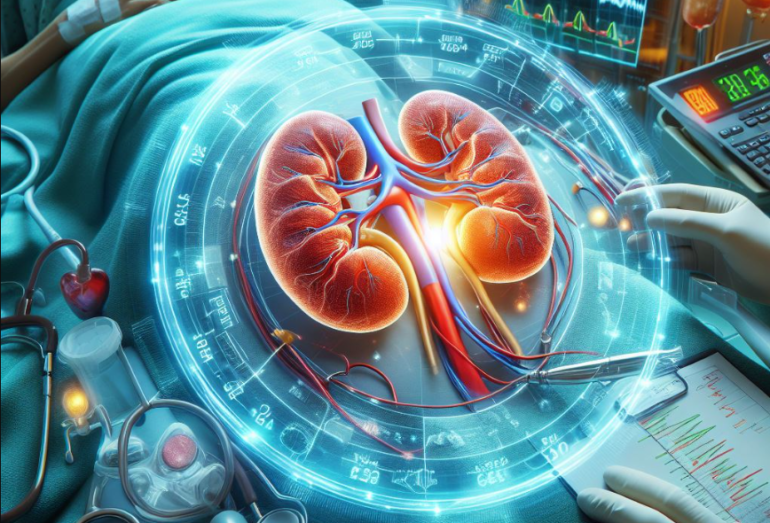TL;DR:
- Researchers introduce an advanced ML algorithm for predicting oliguria, a key indicator of acute kidney injury (AKI) in ICU patients.
- The algorithm’s accuracy is validated in a large patient cohort, showcasing its potential for early AKI detection and intervention.
- The study’s ML model demonstrates outstanding accuracy in forecasting oliguria, outperforming previous models with an AUC of over 0.90.
- Key variables, including SOFA score and urine values, play a crucial role in predicting oliguria at 6 and 72 hours.
- The findings have significant implications for the healthcare market, offering improved AKI management and patient prognosis through early detection.
Main AI News:
In a groundbreaking study recently featured in Scientific Reports, a team of researchers unveiled an ingenious machine-learning (ML) algorithm designed to predict the occurrence of oliguria – a pivotal indicator of acute kidney injury (AKI) in critically ill patients. This innovation promises to reshape the landscape of intensive care by offering a new dimension of accuracy and early detection.
The research team meticulously assessed the algorithm’s reliability within a substantial cohort of patients undergoing treatment in medical and surgical intensive care units (ICUs) at Chiba University Hospital in Japan, spanning from November 2010 to March 2019. Oliguria, defined as a urine output of less than 0.5 mL/kg/h, holds the key to forecasting the onset of AKI, a condition notorious for causing complications during ICU admissions, including severe organ dysfunction and even mortality.
Recognizing the paramount significance of early detection and intervention in enhancing the prognosis of severely ill ICU patients, the study unveils the transformative potential of diagnosing oliguria in AKI management.
Prior studies have explored ML approaches in predicting urine output for critically ill patients, but their precision in anticipating oliguria within the ICU environment remained uncharted territory. In this pathbreaking investigation, researchers harnessed the power of an ML algorithm to forecast oliguria occurrences at both the 6-hour and 72-hour marks, commencing at arbitrary points during a patient’s ICU stay.
AKI was classified as a serum creatinine level that soared at least 0.3 mg/dL above baseline, while oliguria was defined as a urine output of less than 0.5 mL/kg/h. Patient electronic health records (EHRs), the initial study dataset, encompassed a staggering 1,031 input variables, including physiological measurements, blood tests, medication records, general observations, care records, and blood transfusion details.
To construct a robust ML model for oliguria prediction, the research team introduced 222 background information variables, such as age, ultimately culminating in a comprehensive dataset featuring 1,127 variables. Rigorous efforts were made to address potential collinearity issues and handle missing data points with precision.
The performance validation phase featured four ML classifiers subjected to a fivefold cross-validation process, which conclusively demonstrated the model’s impeccable calibration. The LightGBM prediction model stood out as the swiftest and delivered an impressive area under the curve (AUC).
Furthermore, the inclusion of Shapley additive explanation (SHAP) values amplified the interpretability of the ML models. Visualizing the impact of various variables through SHAP individual force plots illuminated the probability of oliguria in two contrasting patient cases—one with oliguria and one without—based on their distinctive traits.
Out of the 9,241 ICU patients under scrutiny, a remarkable 27.4% experienced urine output below 0.5 mL/kg/h for six hours, and a significant 30.2% developed AKI. The ML model exhibited a stellar AUC of 0.964 when predicting oliguria at the 6-hour mark, relying on select variables.
Cross-validation yielded a slightly lower AUC of 0.920, still impressively close to the original AUC, reaffirming the model’s unwavering accuracy in forecasting oliguria at six hours. Key variables deemed significant for predicting oliguria at this juncture included the sequential organ failure assessment (SOFA) score, urine values, serum creatinine levels, creatinine kinase, total bilirubin, oxygen partial pressure (pO2), interleukin (IL)-6, fibrinogen/fibrin degradation products (FDP), and peripheral temperature—variables that also proved influential in predicting oliguria at 72 hours.
A riveting aspect of SHAP analysis unveiled that higher urine volumes decreased the probability of oliguria, while elevated lactate dehydrogenase (LDH) and FDP levels increased this likelihood. Consequently, the model predicted a lower chance of oliguria at six hours for the first patient, and in stark contrast, a higher acute physiology and chronic health evaluation (APACHE) II score, along with lower urine volume, heightened the odds of oliguria for the second patient. Notably, normal uric acid (UA), LDH, and IL-6 levels worked to mitigate the risk in this scenario.
When extended to predicting oliguria at the 72-hour mark, the model continued to shine with an AUC of 0.916, further emphasizing its robust accuracy.
In subgroup analyses, the model’s accuracy experienced a minor decline over time in the female and furosemide groups compared to other groups, yet it maintained a commendable accuracy level with an AUC of 0.86 even at 72 hours.
The authors pointed out that previous ML models to predict AKI in critically ill patients yielded AUCs in the range of 0.74 to 0.93, significantly lower than the exceptional accuracy achieved in the current study (> 0.90). This achievement was attributed to the extensive sample size and the innovative approach of predicting the onset of oliguria from an arbitrary time, thereby enriching the training dataset.
The potential implications of this study are profound, as the early identification of oliguria could revolutionize AKI diagnosis, offering hope for improved patient prognosis through advanced management and timely interventions. The future beckons for further validation and refinement of ML-based prediction models.
Conclusion:
The groundbreaking AI tool’s remarkable accuracy in forecasting kidney injury signs in ICU patients signifies a major advancement in healthcare. This technology has the potential to revolutionize the market by offering a more precise and early detection method for AKI, ultimately improving patient outcomes and reducing healthcare costs associated with severe complications. Healthcare institutions and providers should closely monitor and adopt such innovative solutions to enhance patient care and safety in intensive care settings.

